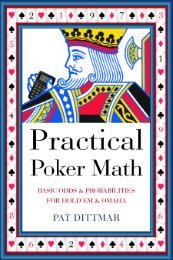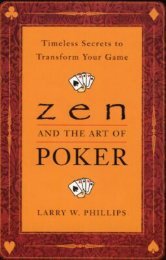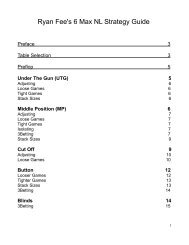Create successful ePaper yourself
Turn your PDF publications into a flip-book with our unique Google optimized e-Paper software.
56<br />
We can multiply these fractions together to find out how often<br />
we do not hit our 8 on the turn or river when we’re all-in on the<br />
flop.<br />
41<br />
45<br />
40 1640<br />
* = = 0.828<br />
44 1980<br />
Now we subtract that from one to find out how often we do hit<br />
the 8.<br />
1 - 0.82 = 0.18 = 18%.<br />
This is exactly what <strong>Poker</strong>stove gave us.<br />
So, that’s the background for understanding where the equity<br />
percentages come from. However, as you’ve seen, using the 4/2<br />
rule is a very easy way to come up with your equity estimate.<br />
We’ll find out why estimating equity is important in future<br />
sections. However, for now, continue to practice estimating your<br />
equity.<br />
One thing I didn’t talk about yet is estimating your equity<br />
preflop. Preflop equities mean very little unless you're going to<br />
be getting all-in preflop. If you're not, the strength of your hand<br />
is much more defined by other factors like your position, the<br />
amount of money remaining in your stack, your opponents and<br />
how your hand will play postflop. In order to determine your<br />
all-in preflop equity, it's easiest to just get used to knowing them<br />
from messing around with a software like <strong>Poker</strong>stove. However,<br />
that’s not the point of this lesson. Later in this book, I'll list<br />
some of the more common all-in preflop situations I've<br />
committed to memory.









